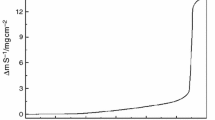Abstract
MOLYBDENUM disilicide is of particular importance in the field of high-temperature materials, both as a structural material in its own right and as an oxidation resistant coating for molybdenum alloys. Apart from having a high melting point of 2,000° C (ref. 1) and good oxidation resistance up to 1,700° C, MoSi2 possesses high-temperature mechanical properties which make it adequate for many applications under static high-temperature oxidizing conditions2.
Similar content being viewed by others
References
Cherniack, G. B., and Elliott, A. G., J. Amer. Ceramic Soc., 47, 136 (1964).
Climax Molybdenum Co. Data Bull. Cdb, 6 (1956).
Powell, C. F., Campbell, I. E., and Gonser, B. W., Vapour Plating (Wiley, New York, 1955).
Searcy, A. W., and Tharp, A. G., J. Phys. Chem., 64, 1539 (1960).
Beidler, E. A., Powell, C. F., and Campbell, I. E., J. Electrochem. Soc., 98, 21 (1951).
Author information
Authors and Affiliations
Rights and permissions
About this article
Cite this article
TODD, G., PARRY, E. Role of Silica in the Oxidation Resistance of Molybdenum Disilicide. Nature 203, 967–969 (1964). https://doi.org/10.1038/203967b0
Published:
Issue Date:
DOI: https://doi.org/10.1038/203967b0
- Springer Nature Limited





